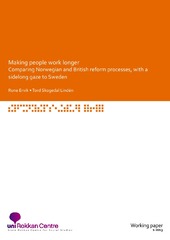| dc.contributor.author | Ervik, Rune | eng |
| dc.contributor.author | Lindén, Tord Skogedal | eng |
| dc.date.accessioned | 2014-03-19T15:13:28Z | |
| dc.date.accessioned | 2020-12-10T06:32:30Z | |
| dc.date.available | 2014-03-19T15:13:28Z | |
| dc.date.available | 2020-12-10T06:32:30Z | |
| dc.date.issued | 2013-03 | eng |
| dc.identifier.issn | 1503-0946 | |
| dc.identifier.uri | https://hdl.handle.net/1956/7871 | |
| dc.description | The present version is based on two slightly different papers presented at the 10th European Social Policy Analysis Network Conference 2012, Edinburgh, Scotland, September 6–8 2012 and at the European Annual Conference of the European Group for Public Administration Conference 2012, Bergen, Norway, September 5–8. | en_US |
| dc.description.abstract | A major strategy of recent pension reforms has been to promote what may be called the «working longer» policy paradigm arguing that working longer represents a win‐win strategy by addressing both the challenge of pension finance sustainability and adequacy. By working longer this extends the contribution period for pensions and reduces the period of pension payments and so helps to balance income and outlays for pensions. Adequacy and social sustainability is improved by increasing the individual earnings basis for future pension benefits and a shorter period in retirement brings higher yearly benefits. The policy measures to bring about these changes are numerous, but in this paper we will deal with two different ways of bringing the factual pension age upwards, considered to be partial substitutes (OECD, 2011): The first one is the straightforward solution of rising the normal retirement age (e.g. the UK). The second strategy is more hidden and implicit, and consists of introducing demographic adjustment factors into the system, that via expected behavioural changes will induce potential retirees to postpone their retirement. Norway (and Sweden) introduced a flexible statutory retirement age where a longevity adjustment factor ensures that people get lower pension benefits if the life expectancy of their cohort increases. A third strategy not considered here relies on a demographic factor that automatically increases the retirement age in correlation with population ageing (e.g. Denmark). This paper aims at exploring the pension reform processes in two countries and answer why countries embark on different paths toward extended working life. We also raise some critical issues regarding the consequences the policy design might have for implementation and peoples´ behaviour and adjustment to the new system. We also question the strategy of automatic stabilizers with respect to information for future pensioners about consequences of different choices and what role street‐level bureaucracies might play in making the implementation of the new pension scheme work according to its intentions, i.e. to make people work longer. Theoretically, we will follow an institutional and ideational perspective. The analysis will rely on policy documents, and interviews made with members of national pension commissions. | en_US |
| dc.description.abstract | Ein hovudstrategi i nyare pensjonsreformer er å få folk til å arbeide lengre. Dette vert framstilt som ein vinn‐vinn strategi som både gjer pensjonssystemet finansielt berekraftig og sikrar tilstrekkelege pensjonar. Å arbeide lengre aukar innskotsperioden medan perioden ein tek imot pensjon vert redusert, og styrkar dermed og balansen mellom inntekter og utgifter i pensjonssystemet. Systemet si sosiale berekraft og grad av tilstrekkelege pensjonsytingar vert forbetra av eit høgare inntektsgrunnlag for den einskilde samstundes som den reduserte tida som pensjonist gjev høgare årlege ytingar. I dette notatet diskuterer vi to ulike måtar ein kan auke den faktiske pensjonsalderen. Alternativa fell delvis saman (OECD, 2011). Det første alternativet er å auke pensjonsalderen slik som i Storbritannia. Det andre alternativet skjer meir skjult gjennom innføringa av ei automatisk levealdersjustering som gir ei spore til at ein skal utsetje pensjonstidspunktet for å oppnå høgare pensjon. Denne løysinga, som Noreg og Sverige har valt saman med ein fleksibel pensjonsalder, inneber at pensjonistane får lågare pensjon dersom levealderen for deira aldersgruppe stig og ein ikkje kompenserer gjennom å jobbe lengre. Andre alternativ, til dømes den danske løysinga kor pensjonsalderen, og ikkje pensjonsytingane, aukar i takt med levealder, vert ikkje omtala. Notatet diskuterer kvifor land vel ulike strategiar for å få folk til å arbeide lengre. Notatet peikar også på kritiske sider ved den norske løysinga, slik som tydinga av tilstrekkeleg informasjon. Notatet tek utgangspunkt i policy ideas litteratur og eit institusjonelt perspektiv, og empirisk byggjer vi på dokument og intervjumateriale | en_US |
| dc.language.iso | eng | eng |
| dc.publisher | Stein Rokkan Centre for Social Studies | eng |
| dc.relation.ispartofseries | Working paper | en_US |
| dc.relation.ispartofseries | 1-2013 | en_US |
| dc.title | Making people work longer. Comparing Norwegian and British reform processes, with a sidelong gaze to Sweden | eng |
| dc.type | Working paper | eng |
| dc.rights.holder | Copyright Stein Rokkan Centre for Social Studies. All rights reserved | |
| dc.description.version | publishedVersion | |
| dc.identifier.cristin | 1019308 | |
| dc.relation.project | 210442 (Norges forskningsråd) | |
| dc.subject.nsi | VDP::Samfunnsvitenskap: 200 | nob |
